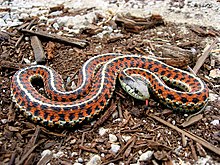Thamnophis elegans
| Western terrestrial garter snake | |
|---|---|
 |
|
| T. elegans terrestris | |
| Scientific classification | |
| Kingdom: | Animalia |
| Phylum: | Chordata |
| Class: | Reptilia |
| Order: | Squamata |
| Suborder: | Serpentes |
| Family: | Colubridae |
| Genus: | Thamnophis |
| Species: | T. elegans |
| Binomial name | |
|
Thamnophis elegans (Baird & Girard, 1853) |
|
| Subspecies | |
|
6 sspp., see text |
|
| Synonyms | |
6 sspp., see text
The western terrestrial garter snake (Thamnophis elegans) is a western North American species of colubrid snake. At least five subspecies are currently recognized.
Most western terrestrial garter snakes have a yellow, light orange, or white dorsal stripe, accompanied by two stripes of the same color, one on each side. Some varieties have red or black spots between the dorsal stripe and the side stripes. It is an immensely variable species, and even the most experienced herpetologists have trouble when it comes to identification. They are medium-sized snakes, usually 46–104 cm (18–41 in).
Like many species of North American garter snake, the western terrestrial garter snake possesses a mildly venomous saliva. Specimens collected from Idaho and Washington produced venom with myonecrotic (muscle tissue-killing) effects when injected into the gastrocnemius muscles of mice. Several cases of mild human envenomation with local edema and other symptoms (but without any systemic symptoms) have occurred from the wandering garter snake subspecies, including in Colorado.
This species is the only garter snake species with a well-documented tendency to constrict prey, although the constriction is inefficient when compared with the constriction of many other snakes (such as the gopher snake), involving disorganized, loose, and sometimes unstable coils and a longer time required to kill prey. Snakes from Colorado populations of terrestrial garter snakes appear to be more efficient at killing their prey by constriction than those from Pacific Coast populations.
Thamnophis elegans is found in central British Columbia, central Alberta, and southwestern Manitoba in Canada. As well in the western United States, as far east as western Nebraska and the Oklahoma Panhandle. An isolated population occurs in Baja California, Mexico.
...
Wikipedia

